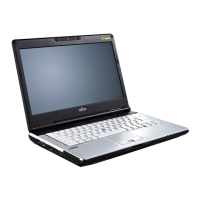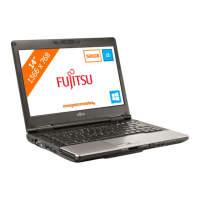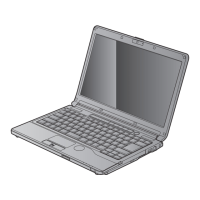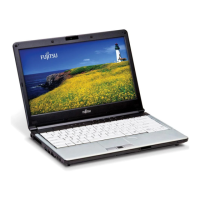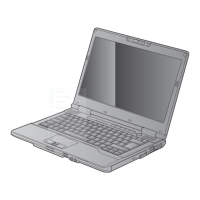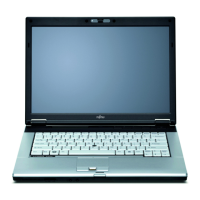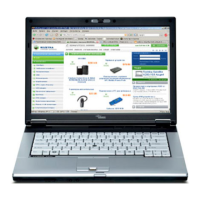Do you have a question about the Fujitsu Lifebook S710 and is the answer not in the manual?
Identifies and describes the various ports and buttons on the notebook.
Explains the meaning of the various status lights on the notebook.
Details the layout and function of the notebook's keyboard keys.
Explains how to use the touchpad for cursor control and scrolling.
Describes the devices that can be housed in the notebook's flexible bay.
Explains the available power sources: battery, AC adapter, and auto/airline adapter.
Guides on powering on the notebook, boot sequence, and initial Windows setup.
Details features for conserving battery power, including Sleep and Hibernate modes.
Provides guidance on diagnosing and resolving common setup and operating problems.
Outlines a procedure to follow before pursuing complex troubleshooting steps.
Addresses common issues with audio, drives, keyboard, modem, USB, and power.
Lists and explains error and status messages generated by the BIOS and operating system.
Covers common wireless LAN connection issues and their solutions.
Details the process of enrolling a user and setting up a master password for OmniPass.
Addresses issues with adding Windows users and dialogs during OmniPass authentication.
Identifies and describes the various ports and buttons on the notebook.
Explains the meaning of the various status lights on the notebook.
Details the layout and function of the notebook's keyboard keys.
Explains how to use the touchpad for cursor control and scrolling.
Describes the devices that can be housed in the notebook's flexible bay.
Explains the available power sources: battery, AC adapter, and auto/airline adapter.
Guides on powering on the notebook, boot sequence, and initial Windows setup.
Details features for conserving battery power, including Sleep and Hibernate modes.
Provides guidance on diagnosing and resolving common setup and operating problems.
Outlines a procedure to follow before pursuing complex troubleshooting steps.
Addresses common issues with audio, drives, keyboard, modem, USB, and power.
Lists and explains error and status messages generated by the BIOS and operating system.
Covers common wireless LAN connection issues and their solutions.
Details the process of enrolling a user and setting up a master password for OmniPass.
Addresses issues with adding Windows users and dialogs during OmniPass authentication.
| Bus type | DMI |
|---|---|
| Stepping | K0 |
| Tjunction | 105 °C |
| Processor cache | 3 MB |
| Processor cores | 2 |
| Processor model | i5-460M |
| System bus rate | 2.5 GT/s |
| Processor family | Intel® Core™ i5 |
| Processor series | Intel Core i5-400 Series |
| Processor socket | BGA 1288 |
| Processor threads | 4 |
| Processor codename | Arrandale |
| Processing Die size | 81 mm² |
| Processor frequency | 2.53 GHz |
| Processor cache type | Smart Cache |
| Processor lithography | 32 nm |
| Processor manufacturer | Intel |
| Processor front side bus | - MHz |
| PCI Express slots version | 2.0 |
| Processor boost frequency | 2.8 GHz |
| Processor operating modes | 64-bit |
| ECC supported by processor | No |
| PCI Express configurations | 1x16 |
| Thermal Design Power (TDP) | 35 W |
| CPU multiplier (bus/core ratio) | 19 |
| Maximum number of PCI Express lanes | 16 |
| Number of Processing Die Transistors | 382 M |
| Motherboard chipset | Intel® QM57 Express |
| HDD speed | 5400 RPM |
| HDD interface | SATA |
| Optical drive type | - |
| Card reader integrated | Yes |
| Total storage capacity | 320 GB |
| Compatible memory cards | Memory Stick (MS), MS PRO, SD |
| Display surface | Matt |
| Display diagonal | 14 \ |
| Display brightness | 220 cd/m² |
| Display resolution | 1366 x 768 pixels |
| Native aspect ratio | 16:9 |
| Internal memory | 4 GB |
| Memory clock speed | 1066 MHz |
| Internal memory type | DDR3-SDRAM |
| Maximum internal memory | 8 GB |
| Maximum resolution | 2560 x 1600 pixels |
| Discrete graphics card model | Intel HD |
| Maximum graphics card memory | 1.695 GB |
| On-board graphics card model | Intel® HD Graphics |
| On-board graphics card base frequency | 500 MHz |
| On-board graphics card dynamic frequency (max) | 766 MHz |
| Type | PC |
| Power supply type | AC |
| Compatible operating systems | Microsoft Windows Vista Business (32-bit), Windows XP Professional |
| Compliance industry standards | IEEE 802.3, IEEE 802.3u, IEEE 802.3ab |
| Audio system | Realtek ALC269 |
| Bluetooth version | 2.1+EDR |
| Cabling technology | 10/100/1000BASE-T(X) |
| Networking features | Gigabit Ethernet |
| Trial software | Symantec Norton Internet Security |
| Pre-installed software | Adobe Acrobat Reader, Application Panel, Display Manager, Power Saving Utility, Wireless Selector Utility, EasyGuide, Nero Essentials S, Norton Internet Security |
| Operating system installed | Windows 7 Professional |
| Certification | CE, CE!, RoHS, WEEE, HCT, HCL entry, WHQL, ENERGY STAR 5.0 |
| Battery life (max) | 8.5 h |
| Number of battery cells | 6 |
| Charging port type | DC-in jack |
| Serial ports quantity | 0 |
| USB 2.0 ports quantity | 3 |
| Cable lock slot type | Kensington |
| Password protection type | BIOS |
| Product type | Laptop |
| Product color | Black, Silver |
| Operating temperature (T-T) | 5 - 35 °C |
| Operating relative humidity (H-H) | 20 - 80 % |
| AC adapter power | 80 W |
| AC adapter input voltage | 100 - 240 V |
| AC adapter output current | 4.22 A |
| AC adapter output voltage | 19 V |
| Battery life with optional 2nd battery | 14 h |
| Pointing device | Touchpad |
| Processor code | SLC22 |
| Processor ARK ID | 50179 |
| Processor package size | rPGA 37.5x 37.5, BGA 34x28 mm |
| Graphics & IMC lithography | 45 nm |
| Supported instruction sets | SSE4.1, SSE4.2 |
| Intel® Turbo Boost Technology | 1.0 |
| Depth | 245 mm |
|---|---|
| Width | 340 mm |
| Height | 35 mm |
| Weight | 2150 g |

